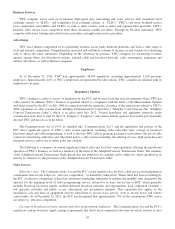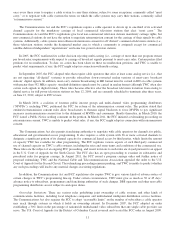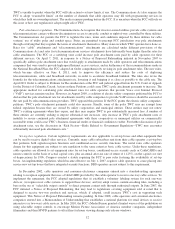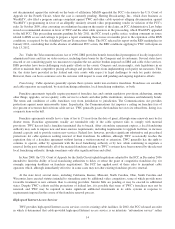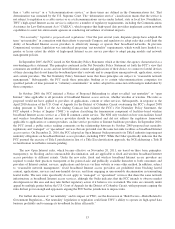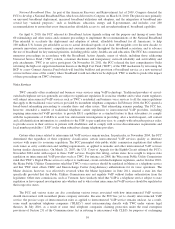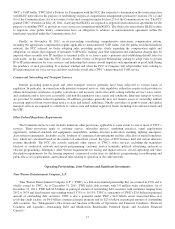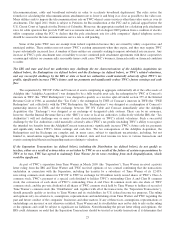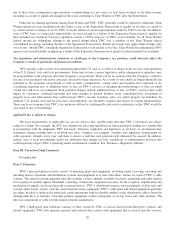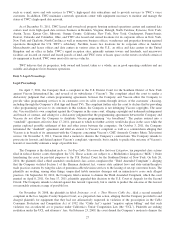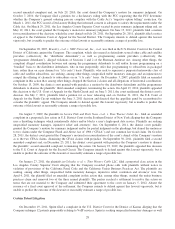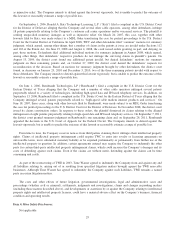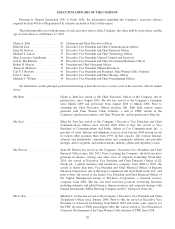Time Warner Cable 2011 Annual Report Download - page 28
Download and view the complete annual report
Please find page 28 of the 2011 Time Warner Cable annual report below. You can navigate through the pages in the report by either clicking on the pages listed below, or by using the keyword search tool below to find specific information within the annual report.Item 1A. Risk Factors.
Risks Related to Competition
TWC faces a wide range of competition, which could negatively affect its business and financial results.
TWC’s industry is, and will continue to be, highly competitive. Some of TWC’s principal residential services
competitors (incumbent local telephone companies, in particular) offer services that provide features and functions
comparable to the residential video, high-speed data and/or voice services that TWC offers, and they offer them in bundles
similar to TWC’s. In a number of TWC’s operating areas, AT&T and Verizon have upgraded their networks to carry
two-way video, high-speed data with substantial bandwidth and IP-based telephony services, which they market and sell in
bundles, in some cases, along with their wireless services.
In addition, each of TWC’s residential services faces competition from other companies that provide services on a
stand-alone basis. TWC’s residential video service faces competition from DBS providers that try to distinguish their
services from TWC’s by offering aggressive promotional pricing, exclusive programming, and/or assertions of superior
service or offerings. Increasingly, TWC’s residential video service also faces competition from companies that deliver
content to consumers over the Internet and on mobile devices, some without charging a fee for access to the content. This
trend could negatively impact customer demand for TWC’s residential video service, especially premium channels and VOD
services, and could encourage content owners to seek higher license fees from TWC in order to subsidize their free
distribution of content. TWC’s residential high-speed data and voice services also face competition from wireless Internet
and voice providers, and TWC’s residential voice service faces competition from “over-the-top” phone service and other
communication alternatives, including texting, social networking and email.
TWC also competes across each of its business high-speed data, networking and voice services with ILECs and CLECs.
TWC’s cell tower backhaul service faces competition from ILECs and CLECs, as well as other carriers, such as metro and
regional fiber providers. TWC’s business video service faces competition from direct broadcast satellite providers. Through
its NaviSite subsidiary, TWC competes with cloud, hosting and related service providers and application-service providers.
In advertising, TWC competes for advertising revenues across many different platforms against a wide range of local and
national competitors.
Any inability to compete effectively or an increase in competition could have an adverse effect on TWC’s financial
results and return on capital expenditures due to possible increases in the cost of gaining and retaining subscribers and lower
per subscriber revenue, could slow or cause a decline in TWC’s growth rates, and reduce TWC’s revenues. As TWC expands
and introduces new and enhanced services, TWC may be subject to competition from other providers of those services. TWC
cannot predict the extent to which this competition will affect its future business and financial results or return on capital
expenditures.
Future advances in technology, as well as changes in the marketplace, in the economy and in the regulatory and
legislative environments, may result in changes to the competitive landscape. For additional information, see “—Risks
Related to Government Regulation,” “Business—Competition” and “—Regulatory Matters.”
TWC faces risks relating to competition for the leisure and entertainment time of audiences, which has intensified in part
due to advances in technology.
In addition to the various competitive factors discussed above, TWC’s business is subject to risks relating to increasing
competition for the leisure and entertainment time of consumers. TWC’s business competes with all other sources of
entertainment and information delivery. Technological advancements, such as new video formats and Internet streaming and
downloading, many of which have been beneficial to TWC’s business, have nonetheless increased the number of
entertainment and information delivery choices available to consumers and intensified the challenges posed by audience
fragmentation. Increasingly, content owners are delivering their content directly to consumers over the Internet, often without
charging any fee for access to the content. Furthermore, due to consumer electronics innovations, consumers are more readily
able to watch such Internet-delivered content on television sets and mobile devices. The increasing number of choices
available to audiences could negatively impact not only consumer demand for TWC’s products and services, but also
advertisers’ willingness to purchase advertising from TWC. If TWC does not respond appropriately to the increasing leisure
and entertainment choices available to consumers, TWC’s competitive position could deteriorate, and TWC’s financial
results could suffer.
20


